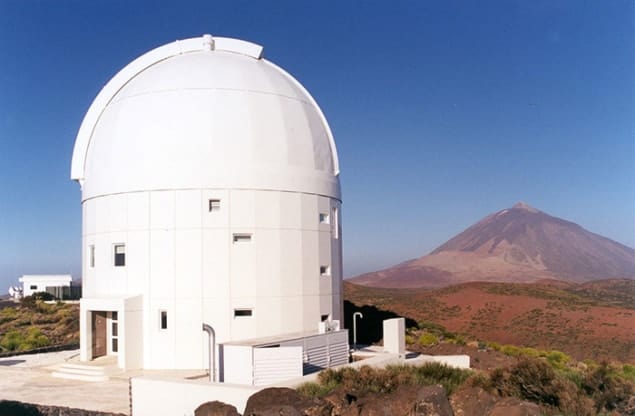
Laser beams encoded with orbital angular momentum (OAM) have been sent a record-breaking 143 km between two islands in the Canaries. Done by physicists based in Austria, this distance is 50 times further than their own previous record for transmitting such “twisted light”. The team says that the results show that it should be possible to encode data using the orbital angular-momentum states of light for both classical and quantum communications, including the transmission of data to and from satellites.
Light possesses two types of angular moment. The familiar phenomenon of polarization is related to the spin angular momentum. OAM, on the other hand, causes a light beam’s wavefront to twist around the direction of propagation, creating a vortex in the middle of the beam. Because the degree of twistedness can in principle take on any value, encoding a beam with OAM can multiply the information-carrying capacity of any fixed-bandwidth classical communication channel many times over. In quantum communications, such encoding would enable each photon to carry more than one quantum bit (qubit) of information, so making the exchange of secret keys more robust against eavesdropping and noise.
Interference problems
A major challenge, however, is to send these twisted beams over significant distances. One approach is to use fibre-optic cables, but it is hard to prevent different OAM modes overlapping with one another as they travel along the cable, and the record distance stands at 1.1 km. The alternative is transmission through the air, but there the problem is turbulence. This causes slight changes to air’s refractive index, which results in interference between different modes.
In 2012 researchers at the University of Southern California sent laser beams with four different twists through about a metre of air. Then, two years later, Anton Zeilinger and colleagues at the University of Vienna and the Institute for Quantum Optics and Quantum Information sent a beam carrying 16 OAM configurations from a tower in the capital of Vienna to a receiver 3 km away. Meanwhile, researchers in Italy and Sweden have demonstrated free-space OAM transmission using radio waves.
Rings of light
In the latest work, Zeilinger’s group has increased the transmission distance to a whopping 143 km. The researchers did so by modulating the phase of a green laser beam sent from the roof of the Jacobus Kapteyn Telescope on the island of La Palma to the Teide Observatory on neighbouring Tenerife. By using the white wall of the observatory as a screen and then imaging the wall with a camera, the researchers were able to distinguish the intensity patterns of beams with different degrees of twist – in each case, a ring of green light surrounding a dark patch of a certain size. In the same way, they could also image beams made from the superposition of two states with equal but opposite twist.
The group carried out its observations over 10 nights in April last year, using a neural network to identify the OAM modes responsible for each intensity pattern recorded. To check the accuracy of their transmitted signals, they used superimposed beams of a given twist with a varying phase difference between the two components. That varying phase difference translated into specific orientations of the lobes in the intensity patterns. The researchers found that their neural network identified the correct orientation about 80% of the time.
Zeilinger and co-workers also used their set-up to encode and decode a short message: “Hello World!”. They represented each letter in the message via three successive beam configurations, with each configuration being one of four different phase settings. In fact, the neural network got the message slightly wrong: it actually read out “Hello WorldP”. But the researchers explain that the error amounted to just one bit out of 72.
Smoke signals
They also point out, however, that the transmission was extremely slow. To improve the accuracy of their message, they recorded five one-second-long exposures for each beam configuration. Adding in the pauses between exposures then led to a total transmission time of 271 s. As Zeilinger and colleagues note, that’s comparable to the speed of smoke signalling.
However, they say that in this demonstration, speed was not of the essence. What mattered instead was showing that the different OAM modes survived the trip. They point out that they were able to do so without using any adaptive optics to compensate for the effects of turbulence. However, they did have to discard results from four of the 10 nights because of strong turbulence or other bad weather. But they say that the transmission quality can be “improved substantially” by adding an adjustable mirror to the laser optics and using suitable software to operate the mirror on the basis of turbulence data obtained from a second laser beam.
The researchers believe that the scheme could be used both to multiplex classical messages and to distribute quantum entanglement of OAM modes. In addition, they point out that because the atmosphere has an effective depth of about 6 km, OAM states sent between the Earth and orbiting satellites using the current scheme should not be significantly degraded by turbulence.
The research is described in a preprint uploaded to the arXiv server.



